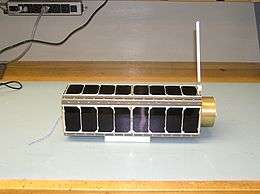GeneSat-1
 The GeneSat-1 satellite. | |
| Mission type | Bioscience |
|---|---|
| Operator | NASA |
| COSPAR ID | 2006-058C |
| SATCAT № | 29655 |
| Mission duration | 21 days |
| Spacecraft properties | |
| Spacecraft type | CubeSat (3U) |
| Manufacturer |
Ames Research Center Stanford University |
| Launch mass | 6.8 kilograms (15 lb) |
| Power | 4.5 W |
| Start of mission | |
| Launch date | 16 December 2006, 06:43:00 UTC |
| Rocket | Minotaur I |
| Launch site | Wallops LA-0B |
| End of mission | |
| Decay date | 04 August 2010 |
| Orbital parameters | |
| Reference system | Geocentric |
| Regime | LEO |
| Eccentricity | 0.00052 |
| Perigee | 413 kilometres (257 mi) |
| Apogee | 420 kilometres (260 mi) |
| Inclination | 40º |
| Period | 92.9 minutes |
GeneSat-1 is a fully automated, CubeSat spaceflight system that provides life support for bacteria. The system was launched into orbit on December 16, 2006, from Wallops Flight Facility.[1] GeneSat-1 began to transmit data on its first pass over the mission's California ground station.
The nanosatellite [2] contains onboard micro-laboratory systems such as sensors and optical systems that can detect proteins that are the products of specific genetic activity. Knowledge gained from GeneSat-1 is intended to aid scientific understanding of how spaceflight affects the human body.
Weighing 5 kilograms, the miniature laboratory was a secondary payload on an Air Force four-stage Minotaur 1 rocket that delivered the Air Force TacSat 2 satellite to orbit. In the development of the GeneSat satellite class (at a fraction of what it normally costs to conduct a mission in space), Ames Research Center (Small Spacecraft Office) collaborated with organisations in industry and also universities local to the center. It is NASA's first fully automated, self-contained biological spaceflight experiment on a satellite of its size.
References
- ↑ "Mission Overview: GeneSat-1". National Aeronautics and Space Administration. Retrieved 28 November 2011.
- ↑ David, Leonard (30 August 2005). "GeneSat-1: Small Satellite Tackles Big Biology Questions". Space.com. Retrieved 28 November 2011.
External links
- a list from the NASA database retrieved 08:55(UTC) October 24, 2011
- GeneSat-1 mission dashboard Santa Clara University Robotics Systems Laboratory retrieved 08:19 24.10.2011